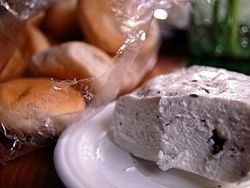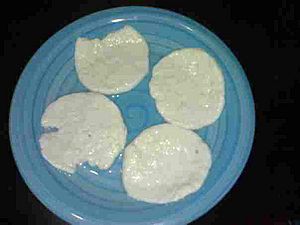Kesong puti facts for kids
Quick facts for kids Kesong puti |
|
|---|---|
 |
|
| Country of origin | Philippines |
| Source of milk | Carabao, Goat, Cow |
| Pasteurised | Yes |
| Texture | Soft |
| Aging time | None |
Kesong puti is a soft, white cheese from the Philippines. It's not aged, meaning it's eaten fresh. It's usually made from carabao milk and salt. To make it, the milk is curdled using vinegar, citrus juices, or sometimes rennet. You can also make it with goat or cow milk. This cheese has a mild salty and tart taste.
When made with acid like vinegar, it's similar to queso blanco or paneer. If made with rennet, it's more like buffalo mozzarella. The cheese can be very soft and jiggly, or firm and pressed. People eat it plain, with bread (like pandesal), or in different Filipino dishes. It's often sold wrapped in banana leaves.
The name, also spelled quesong puti, means "white cheese" in Tagalog. This is what it's called in Laguna and Bulacan provinces. In Cavite, it's known as kesilyo (or kasilyo or quesillo). In northern Cebu, it's called queseo or kiseyo.
Contents
Where Does the Name Come From?
The name Kesong puti comes from the Spanish word queso, which means "cheese." The Tagalog word puti means "white." So, it literally means "white cheese." Other names like kesilyo and queseo come from the Spanish word quesillo, meaning "little cheese."
How is Kesong Puti Made?
Most kesong puti is made by adding an acid to milk. This is similar to how cheeses like queso blanco, paneer, and cottage cheese are made. It's usually made with carabao milk. However, goat or cow milk can also be used, though they produce less cheese.
Making it with Acid
To make kesong puti at home, fresh carabao milk is heated but not boiled. One to four teaspoons of salt are added. The milk is stirred for about 10 to 15 minutes. The best temperature is around 72 to 75°C (162 to 167°F). If it gets too hot (above 95°C or 203°F), the milk proteins can change. This makes it harder for the milk to curdle.
Heating the milk also pasteurizes it. This kills harmful germs and helps the cheese last longer. After heating, about a quarter cup of vinegar or citrus juices (or both) is added. This makes the milk curdle. The milk is then left to curdle for 30 minutes to an hour.
The curds (the solid bits) are then strained using a cheesecloth. This leaves a soft, jelly-like kesong puti. You can press and mold it more to remove extra liquid called whey. In stores, salt is often added after the curdling. This can be done by mixing it in or by soaking the cheese in salty water.
Making it with Rennet
Another way to make kesong puti is by using rennet. Rennet is a special ingredient that helps milk curdle. It can come from plants or from animal stomachs. The steps are similar to using vinegar or citrus. However, the milk needs to be cooled to about 40 to 45°C (104 to 113°F) after heating. This is because rennet doesn't work well at high temperatures.
Like the acid method, the milk is left to curdle for 30 minutes to an hour. The curds are then strained and cut into small cubes. They sit for another 15 minutes to let out more moisture. This method makes more curds and a firmer cheese when pressed. The Philippine Carabao Center uses this method for their kesong puti.
Kesong puti made with rennet is similar to Italian mozzarella di bufala. It doesn't have the sour, vinegary smell that the acid-made versions often have.
How Do People Eat Kesong Puti?

Kesong puti is usually sold wrapped in banana leaves. It tastes mildly salty and tart, and it should not have a strong smell. You can eat it as it is, either fresh or grilled. It's often eaten with bread like pandesal, or with rice cakes such as puto and bibingka. It's also used in various Filipino dishes. Some examples include paella negra and ginataang pakô.
Kesong puti only lasts for about a week. How long it lasts depends on how much salt is used and how firm the cheese is. Softer cheeses spoil faster. You can make it last two weeks to a month if you store it properly in the refrigerator. However, you should never freeze it. Freezing will create ice crystals that ruin its smooth texture.
Different Kinds of Kesong Puti
There are four main areas in the Philippines that make different kinds of kesong puti. These types likely developed on their own. They are from Laguna, Cebu, Cavite, and Bulacan. Here are the most common ways kesong puti is made in these regions:
Laguna Style
Laguna kesong puti comes from Santa Cruz, Laguna. It's mostly made in Santa Cruz, Pagsanjan, and Lumban. The milk comes from nearby towns. Laguna kesong puti traditionally uses rennet from carabao or cow stomachs. It goes through a lactic acid process. Salt is added after, and the cheese is mixed by hand until it's smooth. It's similar to the Cebu version and is firmer than the Cavite and Bulacan types. Santa Cruz has a yearly Kesong Puti Festival.
Cebu Style
Cebuano queseo or kiseyo is mainly made in Compostela and Danao. It's very much like the Laguna version and is made in similar ways. The main difference is that queseo usually has more salt. Also, the molds are lined with muslin cloth, which can be pressed with a weight. This is also a firmer, fermented cheese, like the Laguna type. The town of Compostela celebrates an annual Queseo Festival.
Cavite Style
Caviteño quesillo, kesilyo, or kasilyo is made in General Trias, Cavite, and Tanza. This version uses vinegar to curdle the milk. It is not a fermented cheese. Salt is added to the milk before curdling. A small amount of vinegar is heated to about 60°C (140°F) in a clay pot. Then, the milk is added and stirred until curds form. The curds are strained and shaped into small cups. They are then soaked in a weak salty water solution. This cheese is softer than the Laguna and Cebu versions.
Bulacan Style
Bulacan kesong puti is made in Santa Maria, Meycauayan, and San Miguel. It's similar to the Caviteño version because it's not fermented and mainly uses vinegar. However, more vinegar is used, and the milk is not heated during curdling. The curds are shaped and then soaked in a weak salty water solution.



